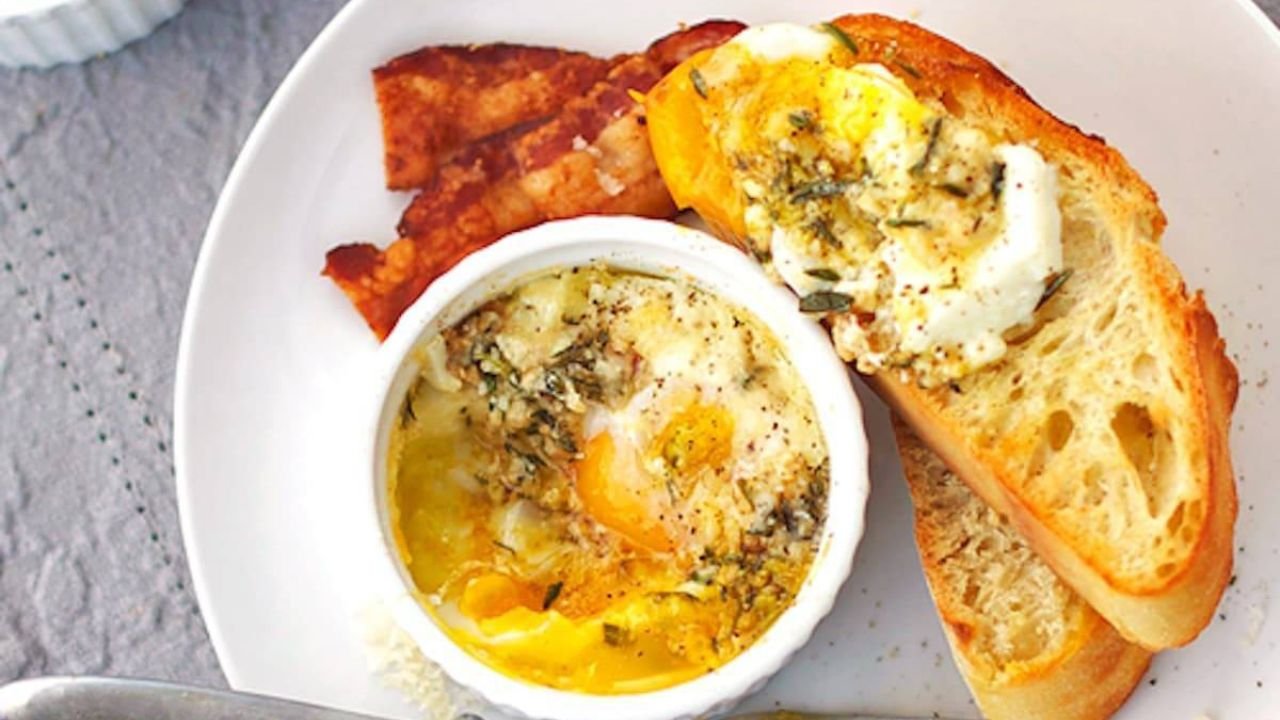Introduction
Eggs have been a staple ingredient in cuisines worldwide for centuries, celebrated for their versatility, nutritional value, and ease of preparation. Among the myriad ways to enjoy eggs, baked eggs—cooked slowly in the oven until set—stand out for their rich texture and elegant presentation.
Parmesan Baked Eggs, in particular, elevate this simple dish by adding a layer of sophistication through the incorporation of Parmesan cheese, herbs, and complementary ingredients. Their warm, gooey centers topped with golden, crispy cheese crust make them a favorite for breakfast, brunch, or light meals.
This comprehensive guide explores the origins, variations, detailed recipes, techniques, nutritional insights, and presentation tips for Parmesan Baked Eggs, aiming to provide you with all the knowledge needed to master this delicious dish.
Historical Context and Cultural Significance
Origins of Baked Eggs
Baked eggs have roots in many culinary traditions across Europe, the Mediterranean, and beyond. The concept of cooking eggs in the oven in ramekins or similar vessels dates back centuries, with variations such as ‘Shirred Eggs’ in Britain and ‘Oeufs Cocotte’ in France.
Parmesan and Its Role in Italian Cuisine
Parmesan, or Parmigiano-Reggiano, is a hard, aged cheese originating from Italy’s Emilia-Romagna region. It has been a cornerstone of Italian cuisine for over a millennium, valued for its umami flavor, granular texture, and ability to enhance dishes both as a topping and as an ingredient.
Fusion of Techniques
Combining baked eggs with Parmesan cheese reflects a fusion of European culinary traditions—simple, rustic egg dishes elevated with the addition of aged cheese and herbs. This pairing exemplifies how humble ingredients can be transformed into refined comfort food.
Variations of Parmesan Baked Eggs
The dish’s versatility allows for numerous variations, each bringing unique flavors and textures. Here are some popular adaptations:
Classic Parmesan Baked Eggs
- Eggs baked in individual ramekins or small baking dishes, topped with grated Parmesan and herbs.
Tomato and Parmesan Baked Eggs
- Incorporates tomato sauce or fresh tomatoes, adding acidity and sweetness, complemented by Parmesan.
Spinach and Parmesan Baked Eggs
- Sautéed spinach or other greens layered beneath or around the eggs for added nutrition and flavor.
Mushroom and Parmesan Baked Eggs
- Sautéed mushrooms provide earthiness, pairing beautifully with Parmesan.
Smoked Salmon and Parmesan Baked Eggs
- Luxurious addition of smoked salmon, capers, and dill for a brunch-worthy dish.
Spicy Variations
- Add chili flakes, hot sauce, or cayenne pepper for heat.
International Twists
- Incorporate ingredients like feta, olives, or herbs like basil and oregano for Mediterranean flair.
Ingredients and Their Roles
Eggs
- The star of the dish, providing richness and protein. Fresh, high-quality eggs yield the best results.
Parmesan Cheese
- Adds umami, saltiness, and a crispy topping when baked. Freshly grated Parmesan offers superior flavor compared to pre-grated varieties.
Dairy
- Heavy cream or milk can be added for creaminess, especially in certain variations.
Herbs and Spices
- Parsley, basil, thyme, chives, or oregano enhance flavor and aroma.
Vegetables
- Tomatoes, spinach, mushrooms, or bell peppers add texture, color, and nutrition.
Proteins
- Ham, bacon, smoked salmon, or cooked sausage can be incorporated for added substance.
Oil and Seasonings
- Olive oil, salt, pepper, chili flakes, and garlic are common flavor enhancers.
Equipment Needed
- Ramekins or individual ovenproof dishes
- Baking sheet
- Whisk or fork
- Grater for Parmesan
- Cooking utensils for sautéing vegetables
- Oven
Step-by-Step Recipe: Classic Parmesan Baked Eggs
Ingredients
- 4 large eggs
- 1/2 cup grated Parmesan cheese
- 2 tablespoons heavy cream (optional)
- 2 tablespoons chopped fresh parsley
- Salt and freshly ground black pepper
- 1 tablespoon olive oil
- Optional: cherry tomatoes, spinach, mushrooms, or ham
Instructions
1. Prepare the Oven and Ramekins
- Preheat your oven to 375°F (190°C).
- Lightly grease ramekins with butter or oil to prevent sticking.
2. Sauté Vegetables (Optional)
- If adding vegetables like spinach or mushrooms, sauté them in olive oil until tender. Season with salt and pepper.
- Spread vegetables evenly at the bottom of each ramekin.
3. Assemble the Dish
- Crack an egg into each ramekin carefully to keep the yolk intact.
- Drizzle with heavy cream if using.
- Sprinkle grated Parmesan cheese over the eggs and vegetables.
- Add herbs, salt, and pepper to taste.
- Top with additional Parmesan for a crispy crust.
4. Bake
- Place ramekins on a baking sheet.
- Bake in the preheated oven for 12-15 minutes, or until egg whites are set but yolks remain runny (or longer if you prefer fully cooked yolks).
5. Serve
- Garnish with chopped parsley or additional herbs.
- Serve immediately with crusty bread or toasted baguette slices.
Tips for Perfect Parmesan Baked Eggs
- Egg Freshness: Use the freshest eggs possible for best flavor and appearance.
- Yolk Consistency: Adjust baking time based on preferred yolk doneness—less time for runny yolks, more for firmer.
- Cheese Quality: Use freshly grated Parmesan for optimal flavor and melting.
- Uniform Baking: Ensure even heat distribution by placing ramekins on a baking sheet.
- Presentation: Serve directly in ramekins or carefully invert onto plates for an elegant presentation.
- Add-ins: Experiment with ingredients like roasted garlic, herbs, or hot sauce to customize.
Variations and Creative Ideas
Mediterranean Style
- Add chopped olives, sun-dried tomatoes, and fresh basil.
Breakfast Pizza
- Use a small crust or toasted bread with baked eggs, Parmesan, and toppings like prosciutto or arugula.
Vegan Version
- Use plant-based cheese alternatives and omit eggs, replacing with tofu or chickpea flour-based scramble.
Gluten-Free Options
- Serve with gluten-free bread on the side or in a gluten-free baking dish.
Make-Ahead Tips
- Prepare vegetables and cheese mixture in advance.
- Bake fresh eggs just before serving for maximum freshness.
Nutritional Profile and Health Considerations
Nutritional Benefits
- Eggs are an excellent source of high-quality protein, vitamins such as B12, D, and choline.
- Parmesan adds calcium, phosphorus, and flavor richness.
- Vegetables contribute fiber, antioxidants, and micronutrients.
Calorie Content
- One baked egg with Parmesan roughly contains 150-200 calories, depending on ingredients and portion size.
Dietary Adjustments
- Use low-fat cheese or dairy substitutes for reduced fat.
- Incorporate more vegetables for added fiber and nutrients.
- Limit salt intake by choosing low-sodium cheese and seasonings.
Considerations for Special Diets
- Those with egg allergies should avoid this dish.
- For low-carb or keto diets, this dish fits well due to its high protein and fat content.
Presentation and Serving Suggestions
- Serve hot directly from the oven in ramekins.
- Accompany with toasted bread, sourdough, or baguette slices.
- Garnish with fresh herbs, chili flakes, or a drizzle of olive oil.
- For brunch, add a side of fresh fruit or mixed greens.
Pairings and Complementary Dishes
- Beverages: Fresh orange juice, mimosa, coffee, or tea.
- Side Dishes: Roasted potatoes, fruit salad, or a light green salad.
- Additional Proteins: Crispy bacon or sausages for heartier meal.
Advanced Techniques and Tips for Professional Results
- Sous Vide Eggs: For precise control over yolk doneness, cook eggs sous vide before finishing in the oven.
- Crispy Parmesan Topping: Mix Parmesan with panko breadcrumbs and bake briefly for crunchy topping.
- Layering Flavors: Incorporate caramelized onions, roasted garlic, or truffle oil for elevated taste.
- Presentation: Use ramekins with decorative rims or serve in individual cast iron dishes for rustic appeal.
Common Mistakes and How to Avoid Them
- Overcooking or Undercooking: Keep a close eye on baking time; eggs continue cooking slightly after removal.
- Soggy Texture: Ensure proper drainage of excess moisture from vegetables.
- Uneven Cooking: Use uniform-sized ramekins and preheat oven thoroughly.
- Cheese Clumping: Grate cheese finely and distribute evenly for meltability.
Environmental and Ethical Considerations
- Egg Sourcing: Choose eggs from reputable sources, such as organic or free-range, for better animal welfare and flavor.
- Sustainable Cheese: Opt for Parmesan produced sustainably and with transparent sourcing.
- Reducing Waste: Use vegetable scraps and leftovers creatively to minimize food waste.
Conclusion
Parmesan Baked Eggs exemplify how simple ingredients—eggs, cheese, herbs—can be transformed into an elegant, satisfying dish suitable for any meal of the day. Their rich flavor, versatile variations, and appealing presentation make them a favorite among home cooks and professional chefs alike.
Mastering this dish involves understanding the nuances of ingredient quality, baking techniques, and flavor balancing. Experimenting with different toppings, fillings, and accompaniments can lead to a personal signature style that elevates your culinary repertoire.
As a dish rooted in tradition yet adaptable to modern tastes, Parmesan Baked Eggs continue to inspire creativity and comfort in kitchens around the world. Whether served as a quick breakfast or a refined brunch centerpiece, they remain a testament to the beauty of simple, well-crafted food.

